‘This is daily life’ in Shatila refugee camp
Guesthouse gives outsiders a glimpse of what life is like inside an overcrowded Palestinian camp in Beirut.

Beirut – Behind the grey walls of southern Beirut’s overrun Shatila camp, young children play video games inside makeshift arcades and men chat animatedly through barbershop windows.
A painting of Yasser Arafat’s face overlooks the camp, while posters incite young people to join the perennial fight to liberate the motherland. It is more Palestine than Lebanon.
Keep reading
list of 4 items‘I blame the government’: Poor Kenyans say no support amid record flooding
‘We need you’: Solomon Islands’ support for US agency’s return revealed
‘Triple spending’: Zimbabweans bear cost of changing to new ZiG currency
The camp has also been offering an alternative accommodation facility, allowing outside visitors to experience what life is like for a refugee in one of Lebanon’s most crowded Palestinian camps.
RELATED: Palestinian refugees struggle with drugs
Inside the heaving refugee camp – originally built for 3,000 in 1949, but is now home for up to 22,000, according to the latest estimates – more refugees trickle in every day, casualties of the Syrian conflict. Electricity is intermittent at best, and the salty water that runs through the pipes is not drinkable.
According to the United Nations Relief and Works Agency (UNRWA), 10 percent of Lebanon’s population is comprised of Palestinian refugees, but 56 percent do not have jobs and two-thirds live on less than $6 a day. UNRWA describes environmental health conditions in Shatila as “extremely bad”, including damp and overcrowded shelters with open drains.
This vibrant slum city has witnessed more bloodshed than its residents care to remember. It was the scene of a brutal massacre 32 years ago, during which upwards of 3,000 residents died at the hands of the Lebanese Christian Phalange militia.
Today, most people welcome outside guests, smiling out of apartment balconies and attempting phrases in English. Others are not so friendly: “You think this is a tourist attraction … a picnic?” one man says.
”Two
, and they said, ‘Why don’t you establish a guesthouse, and the guesthouse can make an income for the centre and those [guests] can try a night in Shatila,’ because everybody hears Shatila is dangerous, dirty, not safe, this and that. So let them have an experience and try it.”]
This is one of the darker interpretations of the Shatila guesthouse, which has been open to outside visitors since 2003. It is the brainchild of the Child and Youth Centre (CYC), an NGO that provides remedial learning for the camp’s underprivileged youngsters and a safe space to play.
The guesthouse, a modest five-room, 16-bed apartment with two bathrooms, a living room and a kitchen in the heart of the camp, is equipped with internet and satellite TV. By February, solar panelling will power it.
Inside the office of CYC director Abu Moujahed, the cacophony of children’s laughter drifts up from the playground outside. The guesthouse is an opportunity for cultural exchange at $15 a night, Moujahed says, noting it will benefit locals and visitors alike.
“Two friends, they used to come [to visit CYC], and they said ‘Why don’t you establish a guesthouse, and the guesthouse can make an income for the centre and those [guests] can try a night in Shatila,’ because everybody hears Shatila is dangerous, dirty, not safe, this and that. So let them have an experience and try it.”
Visitors can get a glimpse into what life is for generations of refugees subjected to tough regulations in their adopted country. Palestinians cannot own property and as many as 20 occupations are off-limits. Driving taxis, for example, is not allowed; one Palestinian driver escorts people to and from the camp in his unmarked, beat-up Toyota.
While the guesthouse is still a relative unknown, with between 40 and 100 guests each year, Moujahed is eager for it to grow and become more upmarket.
“People will come and feel it is a hotel, not a youth hostel,” he said, noting he does not want Shatila to become a “safari” for tourists.
|
|
| Witness – Gaza Hospital: Beirut promo |
“It wasn’t easy to say, ‘I want to make a youth hostel next to a refugee community’ … but we want to attract people to be closer to the community, to be more understanding of the situation … not to come as foreigners, but to be part of the community.”
People need to know what life is like for Palestinians inside and outside of the country, he added. “South Africa had apartheid; now this is the new apartheid in the region, so we should apply pressure together if we believe in world peace.”
Freja Langevang, a 30-year-old Danish university student, recently left the guesthouse after two months. Langevang, who is doing a master’s degree in tourism focusing on the phenomenon of “voluntourism”, is using Shatila and CYC as a case study, although she was initially living outside the camp.
“I stayed in another place for one month, and this was paradise compared to the last place,” she said.
During her time she was mostly alone, though other guests came periodically. “The camp is amazing, especially the people; Lebanese, Palestinians, Syrians, whatever, they’re amazing. They offer you their lives actually, their friendships. You will become part of their family within days and they will help you with whatever they can help you with.”
She says Beirut is a safe and hospitable tourist destination, but Shatila is where she felt most at home.
“Lebanese people told me to stay away from the camp … because it’s not safe, but it’s actually there where I felt the most safe.”
PHOTOS: In Pictures: Clowning around in Lebanon camps
Langevang said she lost perspective of the things an outsider may find disturbing, recalling times when she showed others around. “When I heard them comment on poverty or dirty things, I’d be like, ‘Oh yeah, of course, it’s here,’ because this is daily life, you see it every day, you don’t think about it that much.”
Manar Shamieh is one of the friends Langevang made during her time at the camp. She is Palestinian, but took the unlikely step of moving to Shatila from outside the camp. “I have come to Shatila and live in Shatila because I want to live the same as my people,” she said.
Shamieh said she wants foreigners to see this life first-hand. “My people, they are living in a hard situation. There is no electricity, six hours cut, six hours coming. There is salty water, you cannot wash your face with it [or] drink it … the air is not clean, houses are near to each other.
“It’s enough to stay with us some days and live with us the same hard situation.”
Life inside the stark grey walls can shift perspectives – and once visitors go back outside, the picture of the complicated Beirut is a little bit more complete.
 |
|
CYC director Abu Moujahed speaks inside his office in the Shatila refugee camp [Amanda Fisher/Al Jazeera] |
 |
|
Long-term guesthouse resident Freja Langevang sits in the guesthouse lounge [Amanda Fisher/Al Jazeera] |
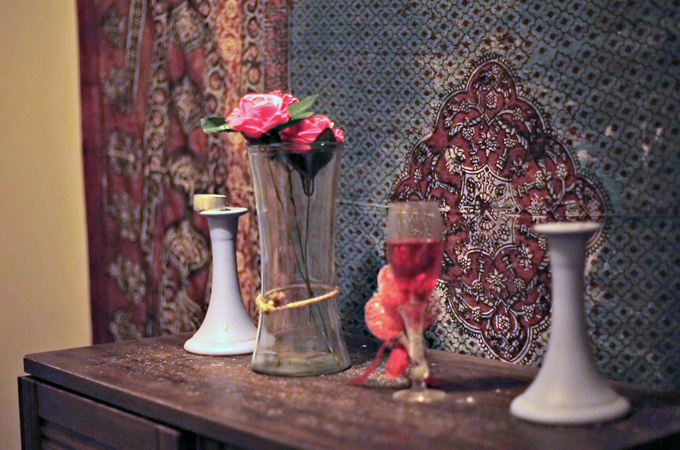 |
|
Vases adorn the entrance to the guesthouse [Amanda Fisher/Al Jazeera] |
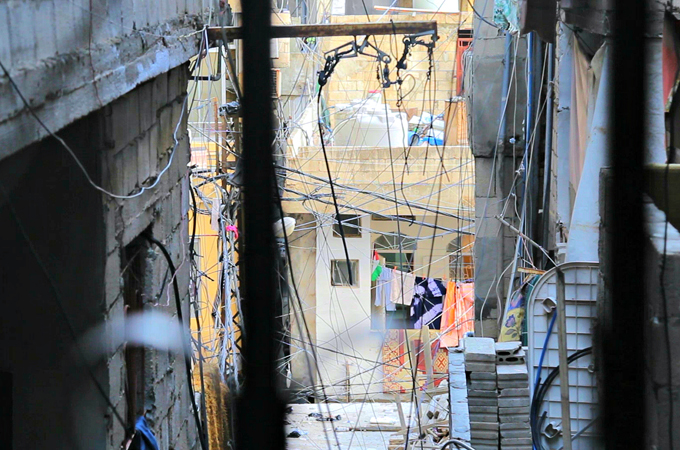 |
|
The refugee camp is seen here through a window at the guesthouse [Amanda Fisher/Al Jazeera] |
 |
|
The Palestinian youth centre is located in the heart of the refugee camp [Amanda Fisher/Al Jazeera] |
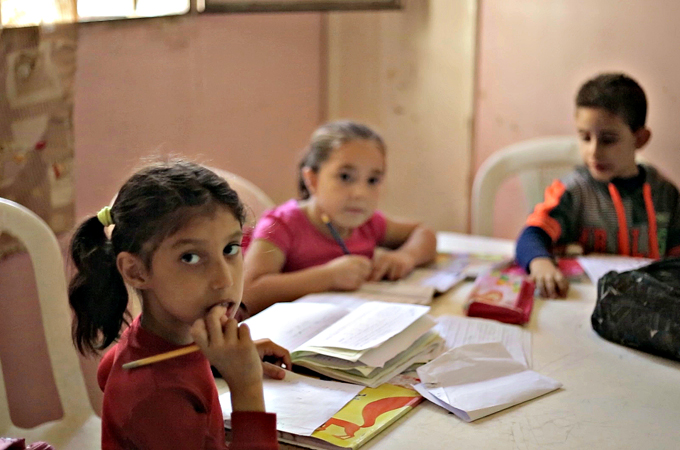 |
|
CYC holds remedial courses for the camp’s children, who have very poor educational records [Amanda Fisher/Al Jazeera] |
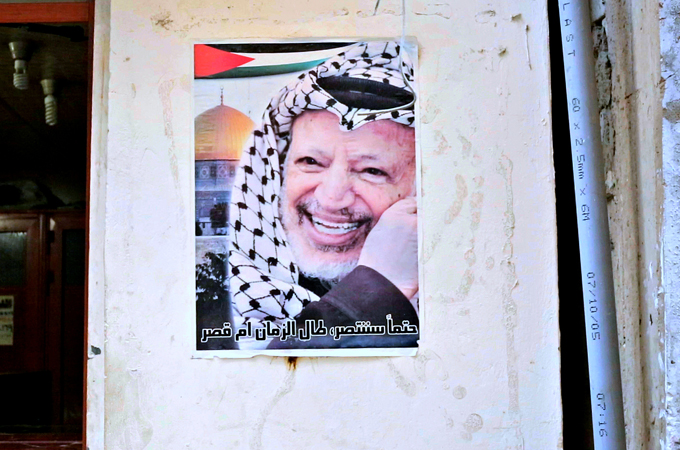 |
|
A poster of Yasser Arafat overlooks the camp [Amanda Fisher/Al Jazeera] |
 |
|
A young boy plays in the CYC playground – the only playground in the camp [Amanda Fisher/Al Jazeera] |
 |
|
Young boys play war games on computers inside an arcade at the Shatila camp [Amanda Fisher/Al Jazeera] |
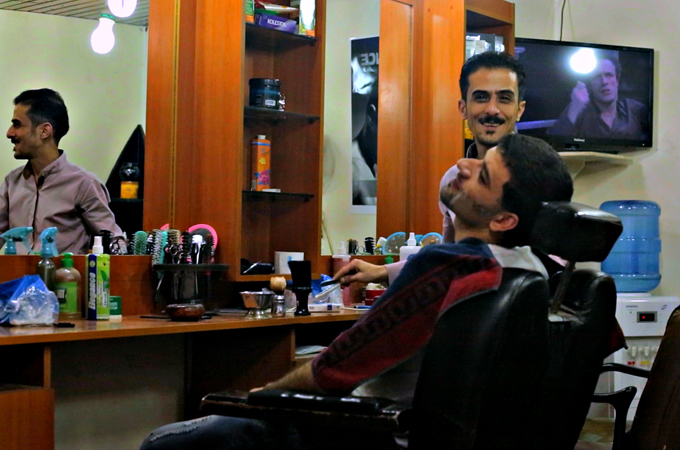 |
|
A man gets a shave at a local barbershop inside the camp [Amanda Fisher/Al Jazeera] |
 |
|
A young Palestinian refugee holds up a peace, or victory, sign [Amanda Fisher/Al Jazeera] |
 |
|
Two young Palestinian refugees walk past a mural painted on a wall inside the camp [Amanda Fisher/Al Jazeera] |
 |
|
A small refugee boy plays on a motorcycle at the camp [Amanda Fisher/Al Jazeera] |
 |
|
A refugee father and his young daughter embrace [Amanda Fisher/Al Jazeera] |